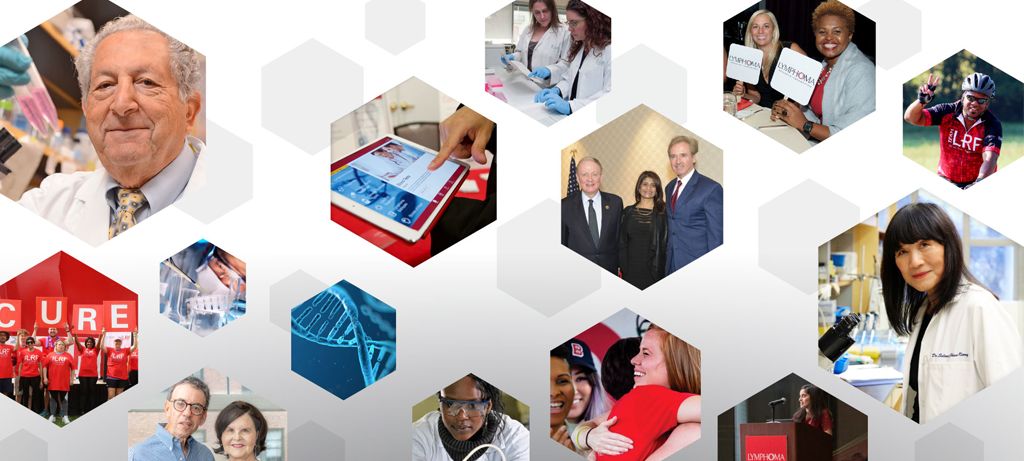Finding Cures Starts Here: 25 Years of Innovation and Progress
1995 was a significant year for the Lymphoma Research Foundation (LRF)—it was then that LRF realized its dual mission: to eradicate lymphoma—by funding innovative research guided by its world-renowned Scientific Advisory Board—and to serve those touched by this disease—by sharing research and treatment insights with the lymphoma community through national education programs.
Finding cures starts here. Through lymphoma-specific research grants and consortia, LRF seeks to understand the nearly 100 subtypes of lymphoma and support the development of new treatments. As a result, LRF-supported researchers have been involved in many of the most significant lymphoma breakthroughs witnessed in the past quarter-century.
25 years of the Lymphoma Research Foundation’s commitment to eradicate lymphoma — 25 years of impacting the lives of all those touched by this disease.
early advances in lymphoma
1975
LRF Scientific Advisory Board member Dr. Kanti Rai (Hofstra Northwell School of Medicine) creates the Rai Staging System to classify the prognosis stage for chronic lymphocytic leukemia (CLL).
1980
Imaging tests begin replacing surgery for Hodgkin lymphoma (HL) staging. In 2016, LRF Scholar and CDA grantee Dr. Anita Kumar (Memorial Sloan Kettering Cancer Center) analyzes the prognostic significance of HL tumor size in the era of improved CT imaging – allowing for measurement of the tumor in multiple dimensions. This unique study allows doctors to identify specific HL patients who may be in need of more aggressive treatment.
1985
Bone marrow transplant shows evidence of successfully curing lymphoma. LRF Board member emeritus Errol Cook is one of the first patients to successfully receive a bone marrow transplant to treat lymphoma.
1991
Ellen Glesby Cohen (in memoriam) establishes the Lymphoma Research Foundation of America (LRFA) after her diagnosis of non-Hodgkin lymphoma, making it the nation’s first organization dedicated to funding lymphoma-specific research. Glesby Cohen was a patient advocate and champion of biomedical research with a focus on lymphoma.
1993
Mantle cell lymphoma (MCL) recognized as a subtype of non-Hodgkin lymphoma (NHL). In 2003, the LRF MCL Initiative is founded, making LRF the largest private funder of MCL research. The initiative transformed the treatment and care of people with MCL.
1994
Jerry and Barbara Freundlich establish the Cure for Lymphoma Foundation (CLF) after Jerry Freundlich’s diagnosis of non-Hodgkin lymphoma. The Freundlichs remain dedicated to finding cures for lymphoma and educating lymphoma patients, survivors and their loved ones about their disease.
innovation & progress
1995
The Scientific Advisory Board (SAB) forms under the leadership of Dr. Joseph R. Bertino (Rutgers Robert Wood Johnson Medical School/Rutgers Cancer Institute of New Jersey) to advance research in lymphoma. Today, the LRF SAB comprises leading lymphoma experts, nine of whom are former LRF grantees.
(photo credit: Nick Rommenko)
1996
The inaugural North American Educational Forum on Lymphoma convenes in California. Today, the LRF Ed Forum is the largest lymphoma-specific conference for patients in the world and inspired a series of regional and local LRF patient programs developed year-round across the nation.
2001
The Lymphoma Research Foundation of America (LRFA) and Cure for Lymphoma Foundation (CLF) merge to create the Lymphoma Research Foundation (LRF), having funded more than $7 million in lymphoma-specific research collectively.
The LRF Mission
2001
Research led by LRF SAB member Dr. Margaret Shipp (Harvard Medical School/Dana-Farber Cancer Institute) advances the cellular and molecular understanding of cancer, leading numerous discoveries related to the treatment of lymphomas, including diffuse large B-cell lymphoma (DLBCL).
2001
Researchers, including LRF SAB members Dr. Ash A. Alizadeh (Stanford University School of Medicine) and Dr. Izidore S. Lossos (University of Miami Health System/Sylvester Comprehensive Cancer Center), discover that diffuse large B-cell lymphoma (DLBCL) is two distinct diseases, each with its own genetic profile.
2002
Adding rituximab (Rituxan) to CHOP chemotherapy (standard of care for the treatment of DLBCL) shows to boost survival. Researchers including former LRF SAB members Dr. Andre Goy (John Theurer Cancer Center) and Dr. Anas Younes present a pilot study of rituximab in patients with recurrent, classic Hodgkin lymphoma (cHL).
2003
LRF hosts its first-ever Lymphoma Walk. Since inception, the Team LRF community fundraising program has raised more than $25 million through fundraising walks, rides, and grassroots fundraisers.
The LRF Team
2003
The LRF Mantle Cell Lymphoma (MCL) Initiative forms, making LRF one of the largest private funders of MCL – funding more than $25 million since inception.
2005
In an LRF-funded study, researchers discover bortezomib (Velcade) shrinks tumors in mantle cell lymphoma (MCL).
Contributions from LRF SAB Chair Dr. Andrew D. Zelenetz (Memorial Sloan Kettering Cancer Center), SAB member Dr. Barbara Pro (Robert H. Lurie Comprehensive Cancer Center of Northwestern University), and past SAB members Dr. Andre Goy (John Theurer Cancer Center), Dr. Owen O’Connor, and Dr. Anas Younes.
2007
LRF SAB member and past Chair Dr. Bruce Cheson and wife Christine Cheson create the Lymphoma Research Ride to raise funds to support LRF’s mission. The Research Ride has raised more than $7 million since its inception.
2008
To expand its first-in-class lymphoma education programming, LRF develops Lymphoma Rounds, a professional education program specifically for those caring for lymphoma patients.
2010
Due in large part to LRF’s Advocacy Program, the U.S. Congress recognizes September as National Blood Cancer Awareness Month (BCAM). LRF launches its BCAM initiative Light it Red for Lymphoma a year later.
2013
LRF launches Focus on Lymphoma, the first app that provides lymphoma patients and caregivers lymphoma educational content and tools to manage their lymphoma.
2013-2014
In the span of a single year, the treatment of CLL was transformed – the FDA approves four new treatments for chronic lymphocytic leukemia (CLL): obinutuzumab (Gazyva), ofatumumab (Arzerra), idelalisib (Zydelig), and ibrutinib (Imbruvica). All four therapies are easier for patients to tolerate than prior therapies, making treatment possible for more patients than ever before. In 2015, LRF hosts the first-ever multi-stakeholder workshop, Oral Therapies in Lymphoma to explore implications of oral therapies in lymphoma and CLL treatment.
2014
LRF launches Erase Lymphoma to raise awareness and provide unique support to adolescent and young adult lymphoma (AYA) patients and survivors.
2014-2016
The FDA approves Immunotherapy drugs nivolumab (Opdivo) and pembrolizumab (Keytruda), helping patients with treatment-resistant Hodgkin lymphoma (HL). In 2016, LRF’s seminal Immunotherapy Response Criteria for Hematologic Malignancies Workshop convenes leading clinicians and researchers to share their experience with immunotherapy agents.
Contributions from LRF SAB members Dr. Stephen Ansell (Mayo Clinic Rochester), Dr. Bruce Cheson, Dr. Leo I Gordon, (Robert H. Lurie Comprehensive Cancer Center), Dr. John M. Timmerman (UCLA Jonsson Comprehensive Cancer Center) and Dr. Margaret Shipp (Dana-Farber Cancer Institute); and Philadelphia Lymphoma Rounds Steering Committee chair Dr. Stephen Schuster (Penn Medicine)
2017
The FDA approves the first gene therapy, CAR T cell therapy, for the treatment of diffuse large B-cell lymphoma (DLBCL). In 2003, LRF funds the first-ever study providing in vivo evidence that CAR T cells are effective in an animal model of blood.
Contributions from LRF SAB and advisors including Dr. Nancy Bartlett (Siteman Cancer Center), Dr. Januario E. Castro (Mayo Clinic, Arizona), Dr. Ian Flinn (Tennessee Oncology), Dr. Jonathan W. Friedberg (James P. Wilmot Cancer Institute), Dr. Andre Goy (John Theurer Cancer Center), Dr. Ronald Levy (Stanford Health Care) , Dr. Patrick Reagan (James P. Wilmot Cancer Institute), Dr. Tanya Siddiqi (City of Hope), Dr. Mitchell R. Smith (GW Cancer Center), Dr. John M. Timmerman (UCLA Jonsson Comprehensive Cancer Center), and Dr. Thomas E. Witzig (Mayo Clinic, Rochester)
2018
LRF achieves more than $60 million funded in lymphoma-specific research.
2019
LRF creates the Adolescent and Young Adult (AYA) Lymphoma Consortium, consisting of pediatric and adult lymphoma experts with an aim to bridge the gap and improve patient care for AYA lymphoma patients and survivors.
2019
LRF hosts the first-ever international scientific workshop on marginal zone lymphoma (MZL).
2019
Due to a study led by LRF SAB member and past chair Dr. John Leonard (Weill Cornell Medicine), past member Dr. Nathan Fowler (MD Anderson Cancer Center) and MCL Consortium member Dr. Ian Flinn (Tennessee Oncology), the FDA approves the first combination and chemotherapy-free treatment improve progression-free survival for patients with slow-growing forms of non-Hodgkin lymphoma.














